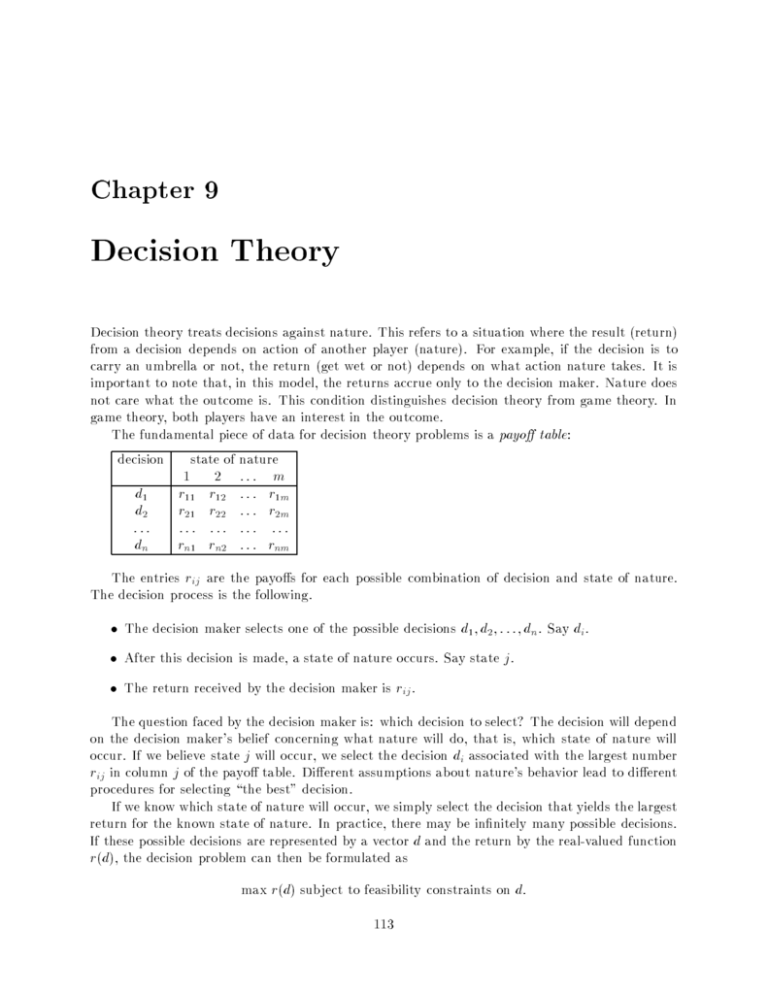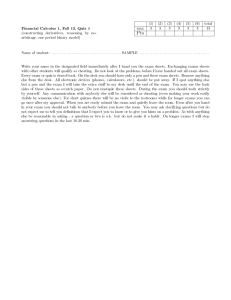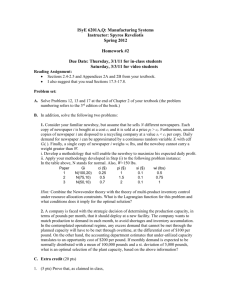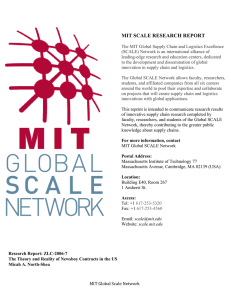Decision Theory - Michael Trick's Operations Research Page
advertisement

Chapter 9 Decision Theory Decision theory treats decisions against nature. This refers to a situation where the result (return) from a decision depends on action of another player (nature). For example, if the decision is to carry an umbrella or not, the return (get wet or not) depends on what action nature takes. It is important to note that, in this model, the returns accrue only to the decision maker. Nature does not care what the outcome is. This condition distinguishes decision theory from game theory. In game theory, both players have an interest in the outcome. The fundamental piece of data for decision theory problems is a payo table: decision state of nature 1 2 ::: m d1 d2 ::: dn r11 r21 ::: rn1 r12 r22 ::: rn2 ::: ::: ::: ::: r1m r2m ::: rnm The entries rij are the payos for each possible combination of decision and state of nature. The decision process is the following. The decision maker selects one of the possible decisions d1; d2; : : :; dn. Say di. After this decision is made, a state of nature occurs. Say state j . The return received by the decision maker is rij . The question faced by the decision maker is: which decision to select? The decision will depend on the decision maker's belief concerning what nature will do, that is, which state of nature will occur. If we believe state j will occur, we select the decision di associated with the largest number rij in column j of the payo table. Dierent assumptions about nature's behavior lead to dierent procedures for selecting \the best" decision. If we know which state of nature will occur, we simply select the decision that yields the largest return for the known state of nature. In practice, there may be innitely many possible decisions. If these possible decisions are represented by a vector d and the return by the real-valued function r(d), the decision problem can then be formulated as max r(d) subject to feasibility constraints on d: 113 CHAPTER 9. DECISION THEORY 114 The linear programming model studied earlier in this course ts in this category. In this case, r(d) is a linear function and the feasibility constraints are linear as well. Many other deterministic models of operations research also fall in this category. In the remainder of this chapter, we consider decisions under risk. 9.1 Decisions Under Risk We make the assumption that there is more than one state of nature and that the decision maker knows the probability with which each state of nature will occur. Let pj be the probability that state j will occur. If the decision maker makes decision di , her expected return ERi is ERi = ri1p1 + ri2p2 + : : : + rimpm: She will make the decision di that maximizes ERi, namely ERi = maximum over all i of ERi: Example 9.1.1 Let us consider the example of the newsboy problem: a newsboy buys papers from the delivery truck at the beginning of the day. During the day, he sells papers. Leftover papers at the end of the day are worthless. Assume that each paper costs 15 cents and sells for 50 cents and that the following probability distribution is known. p0 = Prob f demand = 0 g p1 = Prob f demand = 1 g p2 = Prob f demand = 2 g p3 = Prob f demand = 3 g = = = = 2=10 4=10 3=10 1=10 How many papers should the newsboy buy from the delivery truck? To solve this exercise, we rst construct the payo table. Here rij is the reward acheived when i papers are bought and a demand j occurs. decision 0 1 2 3 state of nature 0 1 2 3 0 0 0 0 ,15 35 35 35 ,30 20 70 70 ,45 5 50 105 Next, we compute the expected returns for each possible decision: ER0 ER1 ER2 ER3 = = = = 0(2=10) + 0(4=10) + 0(3=10) + 0(1=10) = 0 ,15(2=10) + 35(4=10) + 35(3=10) + 35(1=10) = 25 ,40(2=10) + 10(4=10) + 60(3=10) + 60(1=10) = 30 ,45(2=10) + 5(4=10) + 50(3=10) + 105(1=10) = 18:50 9.2. DECISION TREES 115 The maximum occurs when the newsboy buys 2 papers from the delivery truck. His expected return is then 30 cents. The fact that the newsboy must make his buying decision before demand is realized has a considerable impact on his revenues. If he could rst see the demand being realized each day and then buy the corresponding number of newspapers for that day, his expected return would increase by an amount known as the expected value of perfect information. Millions of dollars are spent every year on market research projects, geological tests etc, to determine what state of nature will occur in a wide variety of applications. The expected value of perfect information indicates the expected gain from any such endeavor and thus places an upper bound on the amount that should be spent in gathering information. Let us compute the expected value of perfect information EV PI for the above newsboy example. If demand were known before the buying decision is made, the newsboy's expected return would be 0(2=10) + 35(4=10) + 70(3=10) + 105(1=10) = 45:5 So, EV PI = 45:5 , 30 = 15:5 It should be pointed out that the criterion of maximizing expected return can sometimes produce unacceptable results. This is because it ignores downside risk. Most people are risk averse, which means they would feel that the loss of x dollars is more painful than the benet obtained from the gain of the same amount. Decision theory deals with this problem by introducing a function that measures the \attractiveness" of money. This function is called the utility function. You are referred to 45-749 (managerial economics) for more on this notion. Instead of working with a payo table containing the dollar amounts rij , one would instead work with a payo table containing the utilities, say uij . The optimal decision di is that which maximizes the expected utility EUi = ui1 p1 + ui2 p2 + : : : + uim pm over all i. 9.2 Decision Trees Example 9.2.1 Company ABC has developed a new line of products. Top management is attempting to decide on the appropriate marketing and production strategy. Three strategies are being considered, which we will simply refer to as A (aggressive), B (basic) and C (cautious). The market conditions under study are denoted by S (strong) or W (weak). Management's best estimate of the net prots (in millions of dollars) in each case are given in the following payo table. decision state of nature S W 30 ,8 20 7 5 15 Management's best estimates of the probabilities of a strong or a weak market are 0.45 and 0.55 respectively. Which strategy should be chosen? A B C CHAPTER 9. DECISION THEORY 116 Using the approach introduced earlier, we can compute the expected return for each decision and select the best one, just as we did for the newsboy problem. ERA = 30(0:45) , 8(0:55) = 9:10 ERB = 20(0:45) + 7(0:55) = 12:85 ERC = 5(0:45) + 15(0:55) = 10:50 The optimal decision is to select B. A convenient way to represent this problem is through the use of decision trees, as in Figure 9.1. A square node will represent a point at which a decision must been made, and each line leading from a square will represent a possible decision. A circular node will represent situations where the outcome is uncertain, and each line leading from a circle will represent a possible outcome. P(S)=.45 30 S W A B C P(W)=.55 -8 P(S)=.45 20 S W P(W)=.55 7 P(S)=.45 5 S W P(W)=.55 15 Figure 9.1: Decision Tree for the ABC Company Using a decision tree to nd the optimal decision is called solving the tree. To solve a decision tree, one works backwards. This is called folding back the tree. First, the terminal branches are folded back by calculating an expected value for each terminal node. See Figure 9.2. Management now faces the simple problem of choosing the alternative that yields the highest expected terminal value. So, a decision tree provides another, more graphic, way of viewing the same problem. Exactly the same information is utilized, and the same calculations are made. 9.2. DECISION TREES 117 ER = 9.10 A A B C ER = 12.85 B ER = 10.50 C Figure 9.2: Reduced Decision Tree for the ABC Company Sensitivity Analysis The expected return of strategy A is ERA = 30P (S ) , 8P (W ) or, equivalently, ERA = 30P (S ) , 8(1 , P (W )) = ,8 + 38P (S ): Thus, this expected return is a linear function of the probability that market conditions will be strong. Similarly ERB = 20P (S ) + 7(1 , P (S )) = 7 + 13P (S ) ERC = 5P (S ) + 15(1 , P (S )) = 15 , 10P (S ) We can plot these three linear functions on the same set of axes (see Figure 9.3). This diagram shows that Company ABC should select the basic strategy (strategy B) as long as the probability of a strong market demand is between P (S ) = 0:348 and P (S ) = 0:6. This is reassuring, since the optimal decision in this case is not very sensitive to an accurate estimation of P (S ). However, if P (S ) falls below 0.348, it becomes optimal to choose the cautious strategy C, whereas if P (S ) is above 0.6, the agressive strategy A becomes optimal. Sequential Decisions Example 9.2.2 Although the basic strategy B is appealing, ABC's management has the option of asking the marketing research group to perform a market research study. Within a month, this group can report on whether the study was encouraging (E) or discouraging (D). In the past, such studies have tended to be in the right direction: When market ended up being strong, such studies were encouraging 60% of the time and they were discouraging 40% of the time. Whereas, when market ended up being weak, these studies were discouraging 70% of the time and encouraging 30% of the time. Such a study would cost $500,000. Should management request the market research study or not? CHAPTER 9. DECISION THEORY 118 ERA 20 15 ERC ERB 10 5 0 -5 -10 P(S)=0 0.348 0.45 0.6 P(S)=1 Figure 9.3: Expected Return as a function of P(S) Let us construct the decision tree for this sequential decision problem. See Figure 9.4. It is important to note that the tree is created in the chronological order in which information becomes available. Here, the sequence of events is Test decision Test result (if any) Make decision Market condition. The leftmost node correspond to the decision to test or not to test. Moving along the \Test" branch, the next node to the right is circular, since it corresponds to an uncertain event. There are two possible results. Either the test is encouraging (E), or it is discouraging (D). The probabilities of these two outcomes are P (E ) and P (D) respectively. How does one compute these probabilities? We need some fundamental results about probabilities. Refer to 45-733 for additional material. The information we are given is conditional. Given S, the probability of E is 60% and the probability of D is 40%. Similarly, we are told that, given W, the probability of E is 30% and the probability of D is 70%. We denote these conditional probabilities as follows P (E jS ) = 0:6 P (E jW ) = 0:3 P (DjS ) = 0:4 P (DjW ) = 0:7 In addition, we know P (S ) = 0:45 and P (W ) = 0:55. This is all the information we need to compute P (E ) and P (D). Indeed, for events S1; S2; : : :; Sn that partition the space of possible 9.2. DECISION TREES 119 S A B C W S P(E) E D Test P(D) A B C -8.5 P(S|E) P(W|E) S P(S|E) W P(W|E) S P(S|D) W P(W|D) S P(S|D) S W S -8.5 19.5 6.5 P(S|D) P(W|D) P(S) C S P(S) Figure 9.4: Test versus No-Test Decision Tree 29.5 P(W|D) P(W) W 4.5 14.5 W S 19.5 6.5 A B W 29.5 P(W|E) W W No Test P(S|E) 4.5 14.5 30 -8 20 P(W) 7 P(S) 5 P(W) 15 CHAPTER 9. DECISION THEORY 120 outcomes and an event T , one has P (T ) = P (T jS1)P (S1) + P (T jS2)P (S2) + : : : + P (T jSn)P (Sn): Here, this gives P (E ) = P (E jS )P (S ) + P (E jW )P (W ) = (0:6)(0:45)+ (0:3)(0:55) = 0:435 and P (D) = P (DjS )P (S ) + P (DjW )P (W ) = (0:4)(0:45) + (0:7)(0:55) = 0:565 As we continue to move to the right of the decision tree, the next nodes are square, corresponding to the three marketing and production strategies. Still further to the right are circular nodes corresponding to the uncertain market conditions: either weak or strong. The probability of these two events is now conditional on the outcome of earlier uncertain events, namely the result of the market reseach study, when such a study was performed. This means that we need to compute the following conditional probabilities: P (S jE ); P (W jE ); P (S jD) and P (W jD). These quantities are computed using the formula P (RjT ) = P (TPjR(T)P) (R) ; which is valid for any two events R and T . Here, we get :45) P (S jE ) = P (EPjS(E)P) (S ) = (0:06)(0 :435 = 0:621 Similarly, P (S jE ) = 0:379 P (S jD) = 0:318 P (W jD) = 0:682 Now, we are ready to solve the decision tree. As earlier, this is done by folding back. See Figures 9.5, 9.6 and 9.7. You fold back a circular node by calculating the expected returns. You fold back a square node by selecting the decision that yields the highest expected return. The expected return when the market research study is performed is 12.96 million dollars, which is greater than the expected return when no study is performed. So the study should be undertaken. As a nal note, let us compare the expected value of the study (denoted by EV SI , which stands for expected value of sample information) to the expected value of perfect information EV PI . EVSI is computed without incorporating the cost of the study. So EV SI = (12:96 + 0:5) , 12:85 = 0:61 whereas EV PI = (30)(0:45) + (15)(0:55) , 12:85 = 21:75 , 12:85 = 8:90 We see that the market research study is not very eective. If it were, the value of EV SI would be much closer to EV PI . Yet, its value is greater than its cost, so it is worth performing. 9.2. DECISION TREES 121 15.10 A B C 14.57 P(E) E 8.29 D Test P(D) 3.58 A B C 10.63 11.32 No Test 9.10 A B C 12.85 10.50 Figure 9.5: Solving the Tree CHAPTER 9. DECISION THEORY 122 15.10 P(E) E D Test P(D) 11.32 No Test 12.85 Figure 9.6: Solving the Tree 9.2. DECISION TREES 123 12.96 Test No Test 12.85 Figure 9.7: Solving the Tree Example 9.2.3 An art dealer has a client who will buy the masterpiece Rain Delay for $50,000. The dealer can buy the painting now for $40,000 (making a prot of $10,000). Alternatively, he can wait one day, when the price will go down to $30,000. The dealer can also wait another day when the price will be $25,000. If the dealer does not buy by that day, then the painting will no longer be available. On each day, there is a 2/3 chance that the painting will be sold elsewhere and will no longer be available. (a) Draw a decision tree representing the dealers decision making process. (b) Solve the tree. What is the dealers expected prot? When should he buy the painting? (c) What is the Expected Value of Perfect Information (value the dealer would place on knowing when the item will be sold)? Answer: (a) Buy 10 Buy 20 1/3 Avail Don’t Don’t Sold 2/3 Buy 1/3 Avail Don’t 25 0 Sold 2/3 0 Figure 9.8: Solution (b) The value is 10, for an expected prot of $10,000. He should buy the painting immediately. 124 CHAPTER 9. DECISION THEORY (c) With probability 2/3, the painting will be sold on the rst day, so should be bought immediately. With probability 1/3(2/3) it will be sold on the second day, so should be bought after one day. Finally, with probability 1/3(1/3) it will not be sold on the rst two days, so should be bought after two days. The value of this is 2/3(10)+1/3(2/3)20+1/3(1/3)25 = 13.89. The EVPI is therefore $3,889. Exercise 73 The Scrub Professional Cleaning Service receives preliminary sales contracts from two sources: its own agent and building managers. Historically, 38 of the contracts have come from the Scrub agent and 58 from building managers. Unfortunately, not all preliminary contracts result in actual sales contracts. Actually, only 12 of those preliminary contracts received from building managers result in a sale, whereas 34 of those received from the Scrub agent result in a sale. The net return to Scrub from a sale is $6400. The cost of processing and following up on a preliminary contract that does not result in a sale is $320. What is the expected return associated with a preliminary sales contract? Exercise 74 Walter's Dog and Pony show is scheduled to appear in Cedar Rapids on July 4. The prots obtained are heavily dependent on the weather. In particular, if the weather is rainy, the show loses $28,000 and if sunny, the show makes a prot of $12,000. (We assume that all days are either rainy or sunny.) Walter can decide to cancel the show, but if he does, he forfeits a $1,000 deposit he put down when he accepted the date. The historical record shows that on July 4, it has rained 14 of the time for the last 100 years. (a) What decision should Walter make to maximize his expected net dollar return? (b) What is the expected value of perfect information? Walter has the option to purchase a forecast from Victor's Weather Wonder. Victor's accuracy varies. On those occasions when it has rained, Victor has been correct (i.e. predicted rain) 90% of the time. On the other hand, when it has been sunny, he has been right (i.e. he predicted sun) only 80% of the time. (c) If Walter had the forecast, what strategy should he follow to maximize his expected net dollar return? (d) How much should Walter be willing to pay to have the forecast? Exercise 75 Wildcat Oil is considering spending $100,000 to drill at a particular spot. The result of such a drilling is either a \Dry Well" (of no value), a \Wet Well" (providing $150,000 in revenues) or a \Gusher" (providing $250,000 in revenues). The probabilities for these three possibilities are .5, .3 and .2 respectively. (a) Draw a decision tree for the problem of deciding whether to drill or not. (b) Solve the decision tree assuming the goal is to maximize the expected net revenue. Should the company drill? The following two problems should be done independently. (c) SureFire Consultants is able to determine for certain the type of well before drilling. They oer to tell Wildcat the type for $50,000. Should Wildcat accept their oer? (d) Close-enough Consultants oer to use their specialized seismic hammer. This hammer returns either encouraging or discouraging results. In the past, when applied to a Gusher, the hammer always returned encouraging results. When applied to a Wet Well, it was encouraging 75% of the time and discouraging 25% of the time. When applied to a Dry Well, it was encouraging one-third of the time and discouraging two-thirds of the time. What is the maximum Wildcat should pay Close-enough Consultants for use of their hammer?







